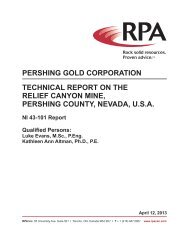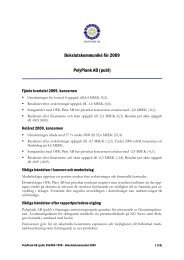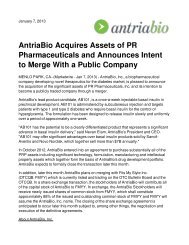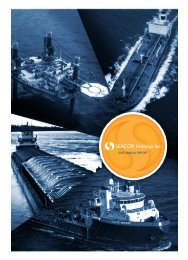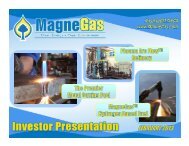ABOUT STWA Applied Oil Technology [AOT™] PRODUCT FACT ...
ABOUT STWA Applied Oil Technology [AOT™] PRODUCT FACT ...
ABOUT STWA Applied Oil Technology [AOT™] PRODUCT FACT ...
Create successful ePaper yourself
Turn your PDF publications into a flip-book with our unique Google optimized e-Paper software.
<strong>ABOUT</strong> <strong>STWA</strong> <strong>Applied</strong> <strong>Oil</strong> <strong>Technology</strong> [AOT]<br />
<strong>PRODUCT</strong> <strong>FACT</strong> SHEET AOT MIDSTREAM<br />
On-Demand Crude <strong>Oil</strong> Viscosity Reduction Industrial Hardware Products<br />
• <strong>STWA</strong>’s AOT Viscosity Reduction System is a suite of commercial crude<br />
oil pipeline flow assurance products, designed for installation at pipeline<br />
pump stations.<br />
• AOT is an industrial efficiency product that is based upon technology<br />
developed by <strong>STWA</strong> Intellectual Property development partner, Temple<br />
University of Philadelphia Department of Physics.<br />
• AOT Viscosity Reduction System offers pipeline system operators key<br />
advantages for flow assurance and is available in Upstream, Gathering, and<br />
Midstream configurations.<br />
• The AOT Viscosity Reduction System is comprised of commercial grade<br />
hardware, designed to allow multiple units to be skid-mounted, and installed<br />
in parallel to accommodate an operator’s flow rate requirements.<br />
• AOT is available in ANSI 150#, 300#, 600# and 900# fittings with maximum<br />
flow rates of up to 5,000gpm per unit (AOT Midstream).<br />
• AOT systems carry the necessary certifications and product approval<br />
stamps as required for use in industrial installations, and can be delivered to<br />
the user for horizontal or vertical orientation installations. Each AOT has<br />
a maximum power consumption of 5kW, and is available in 120/240v 60hz,<br />
and 208v 3ph configurations.<br />
• AOT is available with accessories such as power and control monitoring<br />
systems, and can be adapted for ultra-remote installations by customer<br />
request.<br />
<strong>PRODUCT</strong> HIGHLIGHTS<br />
• Increased maximum flow<br />
rates for given MAOP ratings<br />
• Increased margins of safety<br />
via reduced pressures<br />
required to achieve constant<br />
flow rates<br />
• Reduced power consumption<br />
OPEX for midstream pump<br />
stations<br />
• Reduced wear on midstream<br />
pump and motor assemblies<br />
• Reduced pourpoint and wax<br />
appearance temperatures<br />
• Reduced reliance on bulk<br />
heating systems<br />
• Reduced reliance on<br />
chemical pourpoint WAT<br />
depressants.
AOT MIDSTREAM INSTALLATION<br />
AOT SCIENTIFIC OVERVIEW<br />
<strong>STWA</strong>’s AOT uses a novel,<br />
new method by which to achieve<br />
viscosity reduction, independent<br />
of and supplemental to traditional<br />
methodologies. AOT reduces<br />
viscosity of crude oil without requiring<br />
chemicals, polymers, or application of<br />
heat.<br />
AOT products are based upon a<br />
set of physics principals developed<br />
by Dr. Rongjia Tao, Chair, Department<br />
of Physics, Temple University of<br />
Philadelphia.<br />
The physics principles that operate<br />
within the AOT product line are<br />
DEP-BASED PARTICLE AGGREGATION<br />
Untreated paraffin molecules orient at<br />
random within the base fluid creating<br />
drag between the molecules and<br />
suspending fluid.<br />
AOT Midstream may be installed in either a horizontal or vertical configuration. Vertical “4-pack” shown.<br />
derived from research conducted within<br />
Dr. Tao’s specialization within the field<br />
of electrorheology. Electrorheology is<br />
the study of molecular dynamics within<br />
the presence of electric fields. Dr. Tao’s<br />
research yielded the basic scientific<br />
fundamentals upon which the AOT<br />
product line was derived.<br />
The mechanism by which the AOT<br />
Midstream reduces viscosity is by<br />
introducing a molecular conformational<br />
change phenomenon to the paraffin<br />
and/or asphalt content of the crude oil<br />
by using a function of electrorheology<br />
known as dielectrophoresis (DEP).<br />
DEP induces a dipole moment at the<br />
interface of the molecules/particulate<br />
matter and the surrounding medium.<br />
These dipole moments provide a<br />
net Coulombic force that pulls the<br />
molecules/particulate matter together,<br />
thereby inducing aggregation.<br />
Dielectrophoresis (DEP) allows paraffin<br />
and/or asphalt content of the crude<br />
oil to aggregate into sub-micron<br />
particulate matter clusters (known as<br />
a “conformational change”). These<br />
sub-micron clusters reduce the total<br />
surface area of the paraffin / asphalt<br />
content suspended in the base fluid of<br />
gasoline and diesel, which inherently<br />
reduces the drag of the bulk fluid. It<br />
is this change in conformation that<br />
reduces the viscosity of the fluid itself,<br />
independent of chemical pour point<br />
depressants, diluent, chemical additives<br />
or application of heat.<br />
Once the molecules have been pulled<br />
sufficiently close together, Van der<br />
Waals forces can act to maintain the<br />
aggregated state. However, entropic<br />
forces will eventually cause the<br />
aggregated particles to de-aggregate,<br />
and eventually return to the initial unaggregated<br />
state. The fluid can then<br />
be re-treated to recover the aggregated<br />
state as desired.


![ABOUT STWA Applied Oil Technology [AOT™] PRODUCT FACT ...](https://img.yumpu.com/18893210/1/500x640/about-stwa-applied-oil-technology-aottm-product-fact-.jpg)


